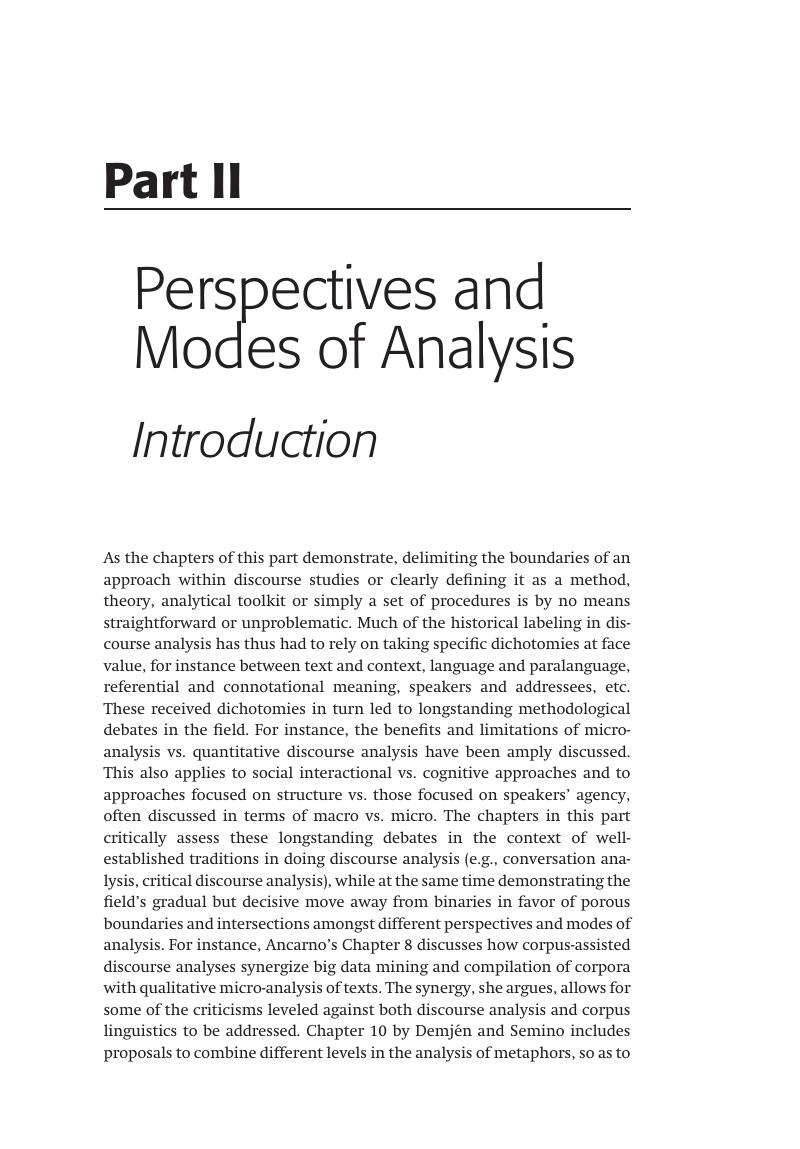Book contents
- The Cambridge Handbook of Discourse Studies
- Cambridge Handbooks in Language and Linguistics
- The Cambridge Handbook of Discourse Studies
- Copyright page
- Contents
- Figures
- Tables
- Contributors
- Preface
- Part I (Con)Textualizing Discourses
- Part II Perspectives and Modes of Analysis
- Part III Discourse Materialities and Embodiment
- Part IV (Trans)Locations and Intersections
- Part V Ethics, Inequality and Inclusion
- Part VI Discourses, Publics and Mediatization
- Index
- References
Part II - Perspectives and Modes of Analysis
Introduction
Published online by Cambridge University Press: 28 September 2020
- The Cambridge Handbook of Discourse Studies
- Cambridge Handbooks in Language and Linguistics
- The Cambridge Handbook of Discourse Studies
- Copyright page
- Contents
- Figures
- Tables
- Contributors
- Preface
- Part I (Con)Textualizing Discourses
- Part II Perspectives and Modes of Analysis
- Part III Discourse Materialities and Embodiment
- Part IV (Trans)Locations and Intersections
- Part V Ethics, Inequality and Inclusion
- Part VI Discourses, Publics and Mediatization
- Index
- References
Summary

- Type
- Chapter
- Information
- The Cambridge Handbook of Discourse Studies , pp. 115 - 254Publisher: Cambridge University PressPrint publication year: 2020
References
Reference
Further Reading
This volume has an excellent collection of different ways in which multiactivity can appear in various contexts and with various practices.
This book covers many of the “stages” found in medical consultations (diagnosis, treatment, etc.) and, as such, provides examples of how full interactions may be broken down into activity units.
This is the primary resource for the details of sequential organization.
References
Further Reading
This collection encompasses studies of communication with older people in different care settings. The range of approaches allows readers to appreciate the insights afforded by different methods.
This is a very influential study in the field of discursive approaches to later life. The data are experimental, but the authors show clearly how detailed analysis of participants’ actual talk reveals more nuance about what is going on in particular exchanges than simple quantitative measures.
This collection offers multiple perspectives on narrative and older age, encompassing not only narrative as therapy but also the way different groups construct themselves through narrative.
This is an excellent collection of essays encompassing a wide range of aspects of communication and ageing. Although the chapters do not explicitly focus on wellbeing, many argue that wellbeing is at issue (for example those by Coupland and Grainger).
This volume explores representations of ageing from several different disciplinary perspectives. Although not all the authors adopt a strictly language-based discourse-analytic approach, the chapters, as a whole, offer insights into the way everyday discourses connect with wider societal discourses.
References
Further Reading
This textbook assumes no prior knowledge of corpus linguistics. It is a useful introduction to how corpus tools can be used in discourse analysis.
This is a substantial edited book comprising thirteen independent studies where corpus linguistics and discourse analytic methodologies are practically combined.
This complements the previous two books in that it encourages students and researchers to critically reflect on CADS research.
References
Further Reading
This book provides an introduction to corpus-assisted critical metaphor analysis with applications to a range of discursive contexts including politics, economics and religion.
This book discusses a range of discursive strategies and linguistic features from a critical cognitive linguistic perspective with example analyses of discourses of national security, war and immigration.
This book provides an introduction to cognitive linguistic critical discourse studies with chapters on structural configuration, identification, framing and positioning. A range of contemporary discourses are analyzed including discourses of riots, strikes and protest, discourses of austerity, discourses of military intervention and discourses of immigration.
This book provides an introduction to multimodality and considers, from a social semiotic perspective, the functions of different parameters, including point of view, in visual and multimodal texts.
References
Further Reading
This shows how metaphor and metonymy are used to promote particular interpretations of a conflict event in Russia. It is argued that, in this way, the structure of the event itself is modified.
This outlines cognitive, discourse-analytic and practice-based perspectives to metaphor and framing, arguing that each is best suited for particular types of research goals. It sets out a blueprint for how different approaches to metaphor and framing can be integrated into a coherent model.
This is a review of the state of knowledge on how and under what conditions metaphors have been found to shape thinking. Theoretical and practical implications, as well as key challenges and opportunities for future research, are highlighted throughout.

